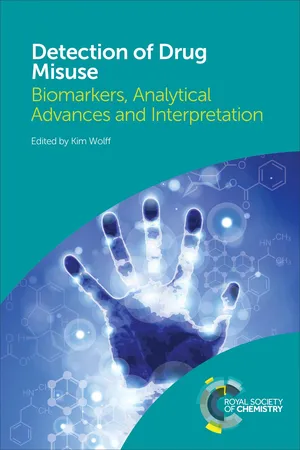![]()
Section I
Analytical Advances in Drug Detection
![]()
1 Urinalysis: The Detection of Common Drugs in Urine
Michael David Osseltona
a Department of Archaeology, Anthropology and Forensic Science, Faculty of Science and Technology, Bournemouth University, Christchurch House, Fern Barrow, Poole, BH12 5BB, UK
*E-mail:
[email protected] 1.1 Introduction and Historical Background
Mathieu Orfila,2 Robert Christison3 and Alfred Swaine Taylor1 were amongst the first early toxicologists in the 18th and 19th centuries to record the use of urine as an aid to poison detection.
“One of the strongest proofs of poisoning in the living subject is the detection of poison by chemical analysis in the matters vomited or in the urine, if the poison be one of those which are eliminated from the kidneys. The evidence is, of course, more satisfactory when the substance is discovered in the matter vomited or in the urine because it will show that the poison has really been taken, and will at once account for the symptoms.”1
At the time of Orfila, Christison and Swaine Taylor, the mechanisms by which poisons exerted their action in the body were unknown, and tests for the presence of poisons in urine were largely associated with administering the urine of suspected poisoning victims to animals, yet urine in the diagnosis and detection of drugs and poisons was later recognised as a valuable matrix for toxicological investigation. Only after the introduction of gas chromatography (GC) into forensic laboratories in the 1960’s were toxicologists able to move away from urine in order to explore the use of blood, where better interpretation can be made from analyses. Today, urine still occupies an important place in forensic, sports, clinical and workplace drug testing, thanks largely to developments in high-performance liquid chromatography linked to mass spectrometry (HPLC-MS).
1.2 Urinary Drug Excretion
Urine is produced in the kidneys and comprises water (>95%) together with the waste products of metabolism. The kidney plays a key function in maintaining the health of an individual by regulating the salt and water balance in the body and providing a route for the elimination of metabolic excretion products and toxic substances. Urine comprises a concentrated solution of filtered waste products that pass out of the body via the bladder. In the healthy individual, the urine is a clear, pale yellow fluid containing water (>95%), urea (∼2%), creatinine (∼0.1%; >2 mmol L-1 or >226 mg L-1) and small quantities of salts, together with water-soluble drugs and their metabolites. The normal glomerular filtration rate is approximately 120 mL minute-1. After reabsorption of salts, glucose and water in the proximal tubules of the kidney, the filtrate reaches the loop of Henle with the same osmotic pressure as plasma at a rate of approximately 20 mL minute-1. After reabsorption of water in the distil tubules, the final urine flow is less than 0.5 mL minute-1. The rate of urine production varies with age, such that a 1-week-old baby produces 50–800 mL 24 hours-1, a 3-year-old child produces 500–700 mL 24 hours-1, a 10-year-old produces 700–1400 mL 24 hours-1 and a healthy adult produces 800–2000 mL 24 hours-1.4
Normal urine has a specific gravity of greater than 1.025. Specimens with a specific gravity of less than 1.001 may indicate dilution caused by excessive fluid consumption, diabetes insipidus, impaired renal function resulting from a low number of functioning glomeruli or, in workplace drug testing scenarios, an attempt by the donor to dilute their urine specimen to try to confound the testing process. Although specific gravity is infrequently measured in post-mortem and criminal toxicology, it is regularly measured in workplace drug testing laboratories as a test for deliberate specimen dilution. The pH of urine is naturally variable and may range between 4.5 and 8.0.
Depending on the pH of the urine and the state of ionisation and/or water solubility of any drugs or their metabolites present in the glomerular filtrate, drugs and their metabolites become trapped in the urine and are subsequently excreted from the body. Although drug concentrations in the glomerulus are similar to those in blood, the reabsorption of water back into the blood as the urine passes through the convoluted tubules and loop of Henle results in increased drug concentrations in urine, such that drug concentrations may be between 10 and 100 times more concentrated in urine than those in the circulating blood.
As a matrix that is largely aqueous and free from proteins and cells in normal healthy individuals (cf. blood), where drug concentrations are usually significantly higher than in blood and where drugs may accumulate prior to elimination from the body, urine provides an ideal sample for drug screening. As a consequence of this concentration effect, drugs and their metabolites may be detected in urine long after they become undetectable in blood; hence, urine analysis provides an extended window of detection for the forensic or clinical analyst. Approximate time intervals for the detection of drugs in urine following single dose consumption are shown in Table 1.1.
Table 1.1 Approximate detection times for determining the presence of drugs and their metabolites in urine following the consumption of a single dose or therapeutic dose.a
| Substance | Detection time (hours)b |
| Alcohol | <24 |
| Amphetamine | 24–36 |
| Diazepam (including metabolites) | 48–72 |
| Temazepam | 48–72 |
| Flunitrazepam/7-amino flunitrazepam | 48–72 |
| THC | 72 |
| Cocaine | <24 |
| Benzoylecgonine | 24–48 |
| GHB (γ-Hydroxybutyrate) | 10–12 |
| Morphine | 24–48 |
| 6-MAM (6-monoacetyl morphine) | 12–24 |
| Codeine | 24–48 |
| Methadone/EDDP | 24–72 |
| MDMA | 24–48 |
| Ketamine/norketamine | 12–48 |
| LSD | <24... |
